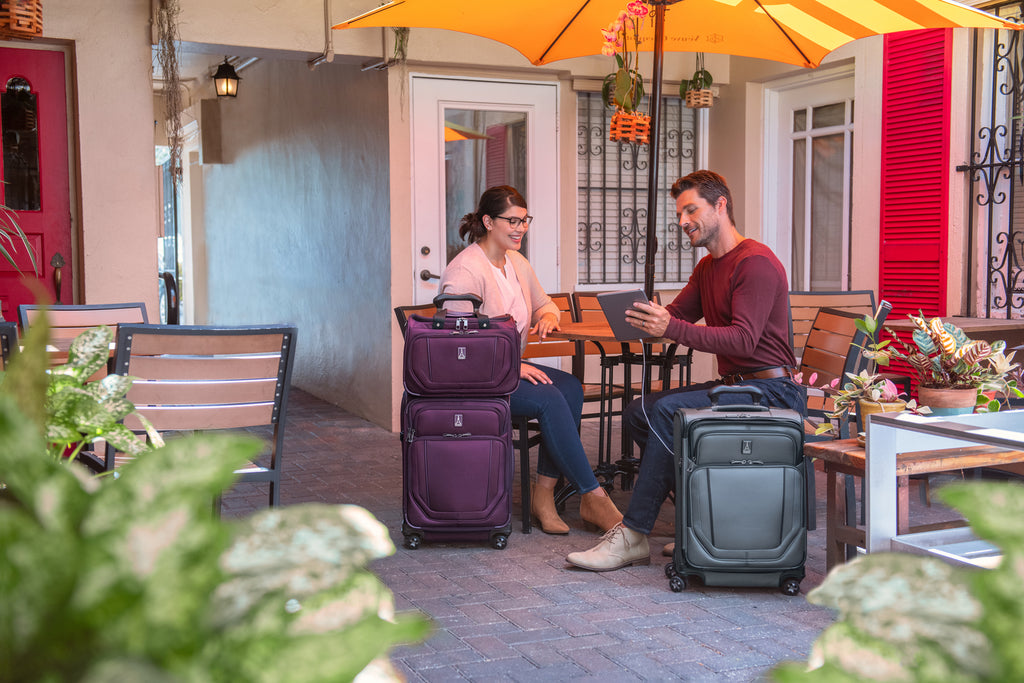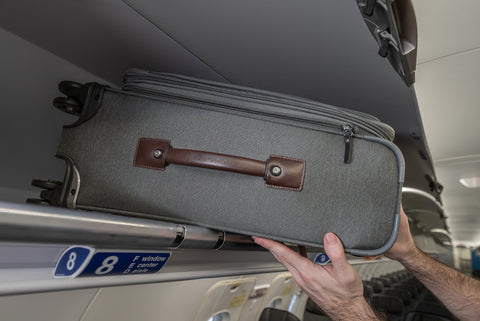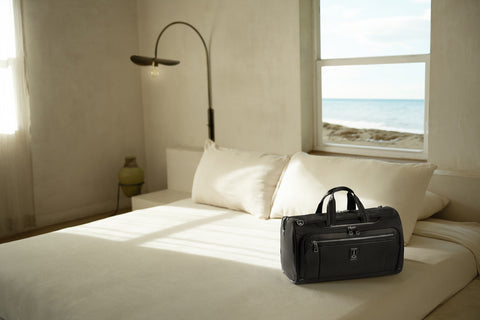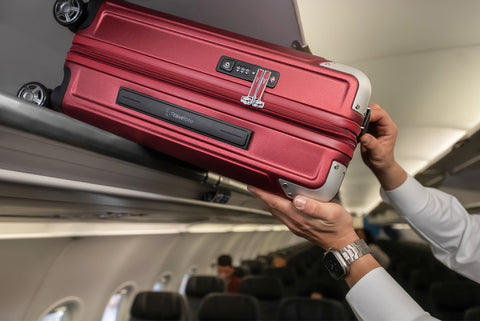Which bags are best for traveling, carry-on vs. checked luggage? Your choice of luggage can have a significant impact on your traveling experience, for good or ill. If you’re thinking about buying your first piece of luggage, you may be unsure of which to buy. Even if you’re a seasoned traveler, you might struggle when choosing between checked luggage vs. carry-ons.
Important Factors to Consider when choosing between carry-on and checked luggage
The nature of your trip will determine whether you can throw some clothes into a carry-on or pack a full suitcase. The most important considerations include baggage fees, how much you need to pack, and whether you’re transporting items that may not be allowed in either carry-on or checked luggage.
How much will you need to pack?
This is the most important consideration when choosing between carry-on luggage vs. checked baggage. If you’re off for a long weekend, you may only need a carry-on bag. If, however, you’re planning to stay several weeks at your destination, or need to transport gifts or business equipment, you’d be better off checking in a full-sized suitcase.
It’s possible to pack ten days of clothing into a carry-on, including two bottoms, five tops, and undergarments. Choose clothes that you can mix and match to create different outfits.
Check-in baggage, in contrast, is usually large enough to pack thirty days of clothing for hot and temperate climates. If you’re heading to a cold destination, the extra bulk of winter clothing comes into play, but you should still be able to pack fifteen days’ worth of clothing into a check-in suitcase
Baggage fees
Baggage fees vary from one airline company to the next. Most airlines charge $30.00 to $35.00 for your first piece of checked luggage, with a second suitcase typically costing $45.00. Oversized bags that are over the airline’s weight limit carry extra charges.
Traditionally, most airlines allowed you one free carry-on. Times have changed, however, and some airlines now charge for carry-on luggage. Airlines may also check the dimensions and weight of carry-on luggage, and may insist you check carry-on luggage if it exceeds their set limits.
Like baggage fees, carry-on size and weight restrictions vary from airline to airline. Most airlines allow carry-on luggage with dimensions of 22” x 14” x 9” or less, but some have smaller requirements. Weight limits vary but can be as low as eleven pounds. Check out Travelpro’s guide to carry-on sizes before you travel, and carry a luggage tag in your carry-on just in case.
Restricted items
The list of items you cannot pack in a carry-on is long and involved. For a complete list of forbidden items check out the TSA website. You cannot pack liquids of any kind in a container larger than 3.4 ounces, some aerosol products, and anything that could be considered a weapon in carry-on (including sporting goods, knives, straight razors, e-lighters, and box cutters).
Less well-known are the items you can pack in carry-on luggage but not in checked baggage. This is a shorter list, but it includes lithium batteries and vaping devices.Benefits of Carry-On Luggage vs. Checked Baggage
Carry-on luggage is best suited for people who like to travel light. You can save on baggage fees and move through airports faster without checked luggage. Carry-on bags come in a wide range of sizes to suit your purposes, from Travelpro’s Maxlite 5 21” Expandable Carry-On Spinner and Platinum® EliteCompact Carry-On Expandable Hardside Spinner to the Crew™ VersaPack™Max Carry-on Expandable Rollaboard or the or the Crew™ Executive Choice™ 3 Large Backpack.
Travel itineraries that work well with carry-on luggage include short visits, trips where you’ll be constantly on the move, and trips to warm climates where you only need light clothing. Other benefits of carry-on luggage include:
-
Quick Check-ins: With no baggage to check-in, you can skip the ticket counter and secure your boarding pass through self-check kiosks or mobile apps.
-
Less Expense: You won’t pay baggage fees (unless the airline also charges for carry-on).
-
Quick Arrivals: Once you disembark, you can move quickly through customs and out of the airport without waiting at the baggage carousel.
- Convenient Packing: If you’ll be constantly moving locations and switching hotels, a carry-on lets you pack up your belongings quickly.
When Not to Use Carry-On Luggage
Don’t be deceived, though. While convenient, carry-on luggage has its downsides. The most obvious problem is one ofluggage size. You’re limited in the amount of clothing and other items you can pack. This makes it difficult to pack clothing for multiple occasions: you’ll probably be wearing the same clothing to dinner that you wore to go shopping. You're also limited in what you can bring home, so you’ll be restricted to small souvenirs and gifts.
Other downsides to carry-on luggage include:
-
Overhead Storage Issues: Not all airplanes have sufficient overhead bin space to store everyone’s carry-on luggage, which may mean your luggage has to be checked anyway.
-
Kids and Carry-ons: If you’re using carry-on luggage to travel with kids, that probably means each kid has their own carry-on. That’s a lot of luggage to keep track of, so you might be better served with check-in luggage.
-
You’re Always Carrying it: You’ll be toting your carry-on throughout your trip, which can get tiring during long layovers or extended walks between boarding gates.
-
Winter Woes: If you’re traveling to a cold climate, a carry-on won’t provide enough space for the heavier clothing you need.
- Slower Security: Without a carry-on bag you can move through security faster
When Should You Use Checked Luggage?
Checked luggage is the best option for serious travelers. It’s the right choice for when you need more packing space, especially if you plan to return home with large souvenirs and gifts. For longer trips of a month or more, checked luggage is the way to go unless you want to live within carry-on size limitations.
Benefits of checked luggage include:
-
Peace of Mind: No need to worry if the airline decides your carry-on is too big or if the overhead compartments will have enough room. You don't even need to worry much about lost baggage, as cases of misplaced luggage dropped sharply over the last decade.
-
Extra Packing Space: Checked-in baggage can hold up to a month of clothing, allowing you to pack a better wardrobe.
-
Bring What You Want: Want to pack an extra pair of shoes, additional clothing, or a clothes steamer? With checked baggage, you have the space to do so.
- Ease of Movement: Once you check-in, you can move freely without toting around a big bag. Sure, you’ll probably want a small carry-on for your essentials and electronics, but a small bag is much easier than hauling a large carry-on through the airport.
Disadvantages of Checked Luggage
Checked luggage, of course, does come with some disadvantages. Checked luggage is generally larger than carry-on bags, and therefore takes up more storage space when you’re not traveling. Checked baggage is more expensive than carry-on bags, but this isn’t a drawback: instead, it’s an investment in long-lasting, durable luggage that provides years of reliable service.
-
Baggage Fees: Checked luggage has to be, well, checked in, which can add to the cost of your trip, especially if you’ll be switching airlines several times to reach your destination.
-
Layover Issues: While many airlines have agreements to move checked baggage, some don’t. This may mean you have to check in your baggage, disembark at the first stage of your journey, collect your baggage, and then recheck it with your new airline. This is a time-consuming process that can become a problem if you have a very short layover.
-
Big Bags are Cumbersome: Large check-in luggage is difficult to maneuver when traveling to and from airports. You can mitigate this issue by choosing lightweight luggage.
- Baggage Claim Delays: At the end of a long trip, the last thing most people want to do is hang around a baggage carousel waiting for luggage.
Choosing between Carry-on Luggage vs. Checked Luggage
So which is right for you? Carry-on luggage or checked luggage? Make your choice based on the type of trip you’re taking. Many people own both and make their decision just before they travel (if you’ve got room to store checked baggage, you can store carry-on luggage inside it). Either way, explore Travelpro’s collections ofcarry-on luggage andchecked luggage. We’re sure you’ll find the suitcase or bag that’s best for you!



